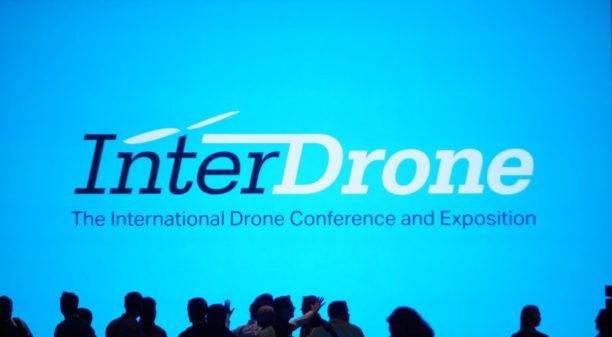From the show floor at this week’s InterDrone Show in Las Vegas: a keynote featuring a discussion between two diverse personalities and market analysts on where the drone industry is headed.
It seems that almost everyone has an opinion on the commercial drone industry. In Point Counter Point, Michael Blades of analysis firm Frost and Sullivan and Colin Guinn of Guinn Partners discuss their viewpoints on industry from two very different backgrounds in drones.
After 21 years in the Air Force, Blades retired and now works for consulting and research firm Frost & Sullivan as Vice President of Aerospace, Defense and Security in the Americas. Blades’ main areas of research and analysis are the unmanned systems and training and simulation markets. VP of Frost and Sullivan
Colin Guinn is a serial entrepreneur and high tech product development expert. (And a reality TV star, featured on the Emmy-Award winning CBS show The Amazing Race). He is currently the founder of Guinn Partners, an autonomous robotics and emerging technology consultancy and investor. He’s got major history and an insider’s view of the commercial drone industry, having been Chief Revenue Officer and 3DR and the original founder and CEO of DJI North America.
Colin has product developed, invented, and/or holds patents for some of the most popular drones in the world, including the DJI Phantom, Zenmuse Gimbal systems, the 3DR Solo, and several others. He provides product development guidance to startups and Fortune 500 companies alike.
The two took a deep dive into case study data to make points about the return on investment of drone programs and where the industry is headed.
“Real revenue is being achieved.”
For the drone industry, accused in the early days of being a solution in search of a problem, this is an important point to be able to make. Blades and Guinn agree, however, that real world data and case studies now offer proof that drone programs are saving enterprise money – significant money.
Assel Ayapova, Global Drone and Robotics Program Manager for AES Corporation, gave Guinn specifics of their savings, saying that drone services firm Measure had successfully identified panels out of service for a savings of about $110,000. Blake Potts, Regional VDC Manager at general contractor firm Brasfield & Gorrie, LLC reported a savings of over $250,000 from using drone photos to identify needs and walk through specific requirements with subcontractors.
Those are big savings: and with repetition over time they offer enterprises who utilize drones a competitive edge over those who don’t.
Now What? Enterprise is Expanding
Having proven the ROI, enterprise programs are growing. That’s not just anecdotal: Guinn and Blades offer examples from major clients indicating plans to move forward with drone use. Firms not only plan to expand, they have lofty goals for full automation for some aspects of operations.
Neill Newton Sr., Product Application Specialist Technology & Engineering at Syngenta is quoted in the presentation as saying: “Our Drone Program is growing rapidly along with the market and involving more and more groups, both internally and externally.”
Kyle Gustofson, PE, a Sr. Transmission Line Design Engineer and Great River Energy UAS Program Manager, says: “My hopes are that we leverage and invest in the technology to capture the value that is available today and continue to push forward a goal of 100% autonomous inspection and analysis of our infrastructure. “
What’s Next for the Industry?
While the evidence of success is there, that won’t lead to explosive growth in the industry. Rather, Guinn says, “The market will experience slow, steady growth with a significant amount of consolidation.” Guinn says that the market is in transition: from being managed by drone enthusiasts to being managed by subject matter experts. Those subject matter experts, he comments, are focused on their core business: and technology that makes it easier to get the aerial data they need will fuel further expansion. “Advances in technology will drive growth by reducing the time that it takes to turn data into decision,” says Guinn.
Miriam McNabb is the Editor-in-Chief of DRONELIFE and CEO of JobForDrones, a professional drone services marketplace, and a fascinated observer of the emerging drone industry and the regulatory environment for drones. Miriam has penned over 3,000 articles focused on the commercial drone space and is an international speaker and recognized figure in the industry. Miriam has a degree from the University of Chicago and over 20 years of experience in high tech sales and marketing for new technologies.
For drone industry consulting or writing, Email Miriam.
TWITTER:@spaldingbarker
Subscribe to DroneLife here.
